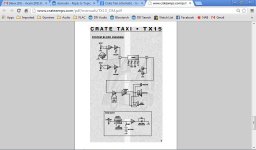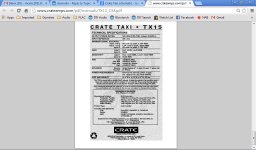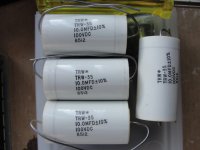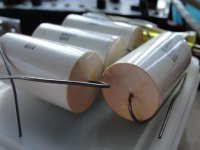I've been heavily modding a Crate Taxi 15Watts acoustic amp and come to the final stages:-
I'd like to change out the non-polar electrolytic coupling caps at the XLR input. They are 10uF and I can't find MKT or MKP that big. I know the XLR is a 600 ohms low impedance circuit and therefore the coupling caps has to be bigger to maintain a reasonable low frequency roll off. Should I parallel a few MKT caps to make up the value ? What is the smallest value you will go for XLR input cap ?
I did search and found not a lot of related info about XLR inputs. Thanks in advance.
-AC
I'd like to change out the non-polar electrolytic coupling caps at the XLR input. They are 10uF and I can't find MKT or MKP that big. I know the XLR is a 600 ohms low impedance circuit and therefore the coupling caps has to be bigger to maintain a reasonable low frequency roll off. Should I parallel a few MKT caps to make up the value ? What is the smallest value you will go for XLR input cap ?
I did search and found not a lot of related info about XLR inputs. Thanks in advance.
-AC
PP (Polypropylene) caps are easily available in 10uF, and larger.
Just search Ebay - "polypropylene 10uF".
Dan.
Just search Ebay - "polypropylene 10uF".
Dan.
Thanks. I didn't realized they are avail in such a big value. I just went to parts-express and they do have 10uf PP type. The only thing I don't like about is their shipping + handling charge. I will keep looking.
Just asking, what would happen if you were to use lets say a 1 uf cap? Would the low end roll off be that exaggerated?
Depends on the impedance of the preceding and following stages....try it, it might be fine.
Sometimes it can be useful to roll out the low bass.
Dan.
Sometimes it can be useful to roll out the low bass.
Dan.
Most 600ohm specified gear is able to drive a load of 600r.
But few Receivers use this 600r as their input impedance.
W.Jung shows that better rejection of interference is available by using very high input impedance at the receiver end of the balanced impedance connection.
From memory he talks of 1M5
Expect a few kohms to many kohms as a typical Zin of balanced receivers.
But few Receivers use this 600r as their input impedance.
W.Jung shows that better rejection of interference is available by using very high input impedance at the receiver end of the balanced impedance connection.
From memory he talks of 1M5
Expect a few kohms to many kohms as a typical Zin of balanced receivers.
Most 600ohm specified gear is able to drive a load of 600r.
But few Receivers use this 600r as their input impedance.
Because that would be BAD - matching impedances provides maximum POWER transfer, and isn't something you want. You're looking for maximum voltage transfer (matching impedances halves the voltage!) and high quality - matching impedances would load the microphone excessively, drastically reducing performance and quality.
Nigel,
many 600ohm balanced impedance transmitters have a low output impedance of well below 100r and some are down around 5r.
That leaves the voltage arriving at a 600r input impedance virtually at the maximum level. Certainly not aimed at maximum power transfer.
many 600ohm balanced impedance transmitters have a low output impedance of well below 100r and some are down around 5r.
That leaves the voltage arriving at a 600r input impedance virtually at the maximum level. Certainly not aimed at maximum power transfer.
Max Headroom;3704605Data says 20k ohm. What are you trying to do ?. Dan.[/QUOTE said:It is interesting to watch the directions the responses are getting into......
Well, I do have the schematic of the amp. What I'd to do is to not having any electrolytic cap in the signal path, in which the last electrolytic caps I want to change out are those at the XLR input of the amp. I will also build a 48v phantom power to inject voltage at the XLR input for my condenser mic to eliminate a preamp that I now put in between the condenser mic and the Taxi amp. Pin 2,3 of XLR feed to the + and - inputs of the TL074 op-amp via a pair of 10uF non-polarized electrolytic caps.
If the input impedance is 20k and the output impedance of the condenser mic is standard 600R (XLR), then I think a lower value input cap should be sufficient. But I read many XLR amplifier schematics and they are all using bigger input caps such as 10uF (some in the range of 20uF) therefore I think there is a reason (my guess is probably to preserve low freq roll off). Other coupling caps in the Taxi amp are of 1uF only.
I may just have to do some trial and error and see how low the value I can get by.....
Nigel,
many 600ohm balanced impedance transmitters have a low output impedance of well below 100r and some are down around 5r.
But you can't rely on that, the specification is for 600 ohm output impedance, so you can't rely on the source been considerably lower (although it may well be) - and as designing the input impedance higher gives less loading anyway, there's no reason not to do so.
Just Do It.....
Microphone - Wikipedia, the free encyclopedia
AC, your plan will work out fine...go for it.
Dan.
Microphone - Wikipedia, the free encyclopedia
Microphones have an electrical characteristic called impedance, measured in ohms (Ω), that depends on the design. Typically, the rated impedance is stated.[32] Low impedance is considered under 600 Ω. Medium impedance is considered between 600 Ω and 10 kΩ. High impedance is above 10 kΩ. Owing to their built-in amplifier, condenser microphones typically have an output impedance between 50 and 200 Ω.[33]
AC, your plan will work out fine...go for it.
Dan.
Mundorf M-Caps in the 10uF 250VDC size are only $7 each. This series is my go-to for entry level film caps for simple upgrade projects such as CD player output stages, T-amp input caps, etc. Link: Mundorf MKP Series Film Capacitors
Thanks for all replies and ideas. Today I bought these big TRW 10uF 100v caps from a surplus store. They are big: 1.5" long, 0.75" dia.
I can't find much info on them on the internet. Only found some info that they made good caps for aerospace/aircraft application etc. Not even sure if this is PP cap or polyester or etc.
I am sure anything in this category will be better then those small electrolyte caps.
Anyone know anything about TRW caps?
I can't find much info on them on the internet. Only found some info that they made good caps for aerospace/aircraft application etc. Not even sure if this is PP cap or polyester or etc.
I am sure anything in this category will be better then those small electrolyte caps.
Anyone know anything about TRW caps?
Attachments
What about bathtub paper in oil caps from the ham radio era, russian surplus as well as NOS is common and pretty cheap.
You're right about there not being much info on these TRW-35 caps. One eBAy store mentioned them as axial electrolytics, but two other suppliers mention them as axial polyester film.
Last edited:
at this point i'll reread the thread but i'm wondering why you need to replace these caps?
Check the first post.
- Status
- Not open for further replies.
- Home
- Live Sound
- Instruments and Amps
- XLR input coupling cap replacement ?



